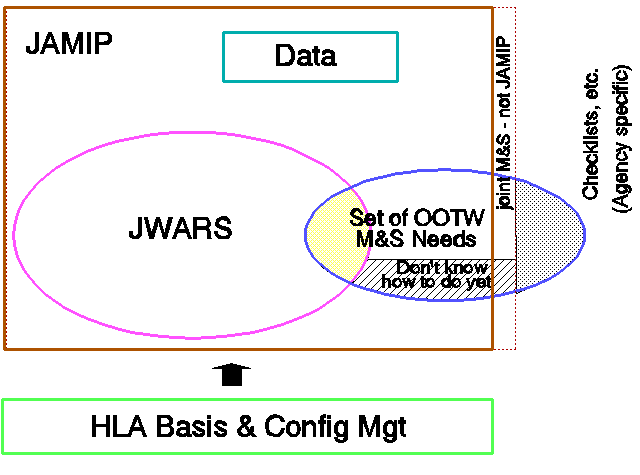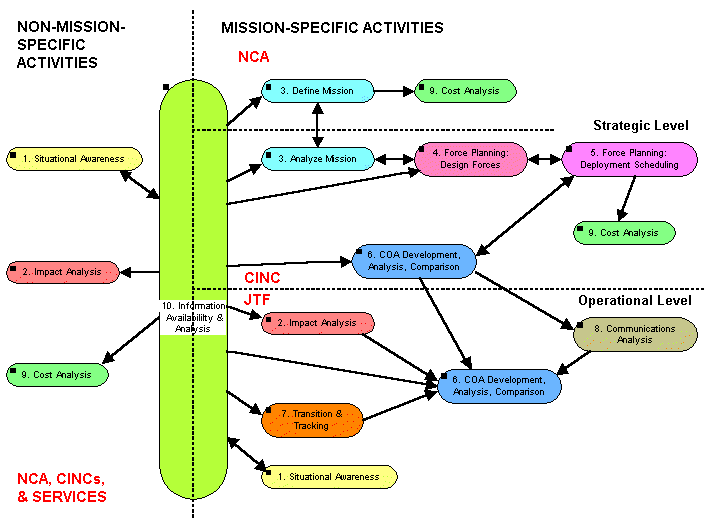
Page Last Updated: Tuesday, 19 January 2016 11:02 EDT, © 1998, 2002, 2008, 2012, 2016
There is a clear need within the OOTW community for the development of analytical tools to support OOTW issues. There are dozens of tools, with varying utility, for a number of OOTW requirements. However, there is no single source that assimilates and evaluates all of these tools. The intent of this site is to provide such a capability.
| Project Metadata | Keywords | ||||||||||||||||||||||||||||||||||||||||||||
|
|
The OOTW Tools Project identified 10 requirements for analysis tools. Each requirement is described in accompanying web pages in terms of the tool (or tools) needed to satisfy the requirement, the tasks that the requirement supports, the requirement's priority, a characterization of the difficulties involved in satisfying the requirement, and recommended action.
OSD PA&E is supporting a project to to identify tools that match the OOTW requirements, to identify "missing" tools, and to determine how the tools should be developed. This website is a part of that effort. Figure 1. shows the JWARS model and its data sources as contained within the Joint Analytic Model Improvement Process (JAMIP), supported by the High Level Architecture (HLA) and Configuration Management. It also shows the relationship of the analytic tool needs for OOTW and JWARS/JAMIP. Some OOTW Modeling and Simulation (M&S) needs may be supported by JWARS, some may be supported within JAMIP, but not JWARS. Some OOTW analytic tool needs may be specific to only parts of the community and some may be common to the general analytic community, but not within the purview of JAMIP. The figure also indicates that there are some M&S needs that require research before valid models can be created and that these needs may (or may not) be supported by JAMIP.

Figure 1. Relationships between JWARS and OOTW requirements.
The Operational Requirements Definition (ORD) Process for JWARS will declare whether JWARS must have functionality in the OOTW domain, that is, whether there is a non-empty intersection, as shown in the figure. As a result of this website, and your participation, the OSD (PA&E) project will make recommendations about the precise OOTW functions to be included in JWARS and JAMIP, that is, how big the various intersections should be, and make recommendations on tools that could be useful in these areas.
The following table shows the ten requirements that were identified as needed to support OOTW analysis. The requirements (Rqmt), user level (Use), priority (P), and recommended actions (Act) are shown in the following table. Priorities for each requirement are taken from a five-point scale. A priority of "1" represents a critical need for an automated supplement to current procedures, a "3" represents an important need, and a "5" represents an enhancement. Requirements scoring below a "3" have been dropped from this report. The priority values represent the consensus values of a group of knowledgeable analysts, including Combatant Command, Service, and Joint representatives. The recommended action for each tool is based on the priority and the estimated difficulty of developing the tool. Two basic actions are recommended, either "do now" or perform "research and development." One requirement has a modified "do now" recommendation of "start now," indicating an estimate of a more complex modeling/data problem.
Each requirement is described in the linked page in terms of the tool (or tools) needed to satisfy the requirement, the tasks that the requirement supports, the requirement's priority, a characterization of the difficulties involved in satisfying the requirement, and recommended action. The requirement page contains a table of tools matched against the tasks. The table is known to be incomplete. There is also a linked page of data about all the tools. The very large number of empty cells indicates lack of knowledge. You are encouraged to "open" each of these 10 areas and the tool data area, study the information provided, then make comments on what you see. Your expertise is needed!
Table 1. Requirements
| Rqmt | Title | Description | Use | P | Act |
|---|---|---|---|---|---|
| 1 | Situational Awareness |
supports the generation of a complete picture of the current and likely future situation | NCA CINC JTF Serv |
2 | start now |
| 2 | Impact Analysis |
supports the analysis of the impact of human actions (own-side, opposition or neutral parties) on the current situation and on future plans | NCA CINC JTF Serv |
1 | R&D |
| 3 | Mission Definition and Analysis |
supports mission definition in its broadest sense | NCA CINC JTF |
2 | do now |
| 4 | Force Planning: Design Forces |
supports the design of supporting and supported forces for use in OOTWs, where the supported forces may consist of forces that belong in the supporting category in combat operations - both parts may include U.S. non-military and non-U.S. elements | CINC Serv |
1 | do now |
| 5 | Force Planning: Deployment Scheduling |
supports the timing and prioritization of deployment scheduling, including U.S. non-military and non-U.S. elements | CINC | 1 | do now |
| 6 | COA Development, Analysis, Comparison |
supports COA development, analysis, comparison, estimates of success and casualty predictions, risk modeling, and recommendations | CINC JTF |
1 | R&D |
| 7 | Transition Planning and Tracking of Operational Data |
supports continued planning of the transition and tracking of MOEs, MOPs, end-state and transition criteria, and analysis of such things as casualties and medical treatments | CINC JTF |
3 | do now |
| 8 | Communication Analysis |
supports communications analysis, including interoperability of non-U.S. and non-military equipment | CINC JTF |
3 | R&D |
| 9 | Cost Analysis | models costs of generic OOTWs for use in national force structure planning, input to decisions on engaging in an OOTW, and to estimate comparative costs during mission planning | NCA CINC JTF Serv |
3 | do now |
| 10 | Information Availability and Analysis |
supports data collection and analysis and use by other tools | NCA CINC JTF Serv |
1 | do now |
None of the requirements is completely independent of the others. The major relationships among the 10 requirements are shown in Figure 2. Each requirement may be accessed through its link(s) in the figure. Some requirements support multiple functions, within the time and level of authority divisions shown in the figure. Some requirements, such as Cost Analysis, are repeated, indicating the possible need for differing tools, whereas the Information Availability & Analysis requirement is shown as a single entity, spanning and serving all divisions.

Figure 2. Relationships among the requirements.
Developing the OOTW analysis tools requirements entailed the development of an OOTW Analysis Taxonomy. Numerous sources define the various types of OOTW [2, 6, 12, 13, 16] and group them in various ways. Unfortunately, the definitions do not all agree and no one source contains all definitions. The result is that simply choosing one source as a base source and adding the remaining definitions from other sources does not result in a consistent set of definitions. Further, the groupings that are needed for defining analysis tools to support OOTWs must be based on similarities of tool functionality, not necessarily on similarity of the OOTWs based on such things as political structures. This situation necessitated the careful creation of a taxonomy for OOTW analysis based on tool requirements alone. In addition to the definitions from the sources above, documents by knowledgeable analysts [31, 88, 104, 117, 141, 152] were also consulted. However, the final decisions were made by a group consisting of Combatant Command, Service, and Joint representatives. The three dimensions chosen to span the taxonomy were: OOTW analysis categories, OOTW analysis tasks, and OOTW analysis attributes.
Hartley, Dean S., III. Operations Other Than War: Requirements for Analysis Tools Research Report, K/DSRD-2098. Lockheed Martin Energy Systems, Inc., Oak Ridge, TN: 1996.
Staniec, Cy, et al. MORS Workshop on OOTW Analysis and Modeling Techniques (OOTWAMT). Military Operations Research Society, Alexandria, VA: 1997.
Many other references were used to understand OOTWs. You may find that many are also useful to your work. If you know of other references that are germane to the OOTW area, please let me know of them, with the cross-reference information.
If you arrived here using a keyword shortcut, you may use your browser's "back" key to return to the keyword distribution page.
Return to
Hartley's Projects Page